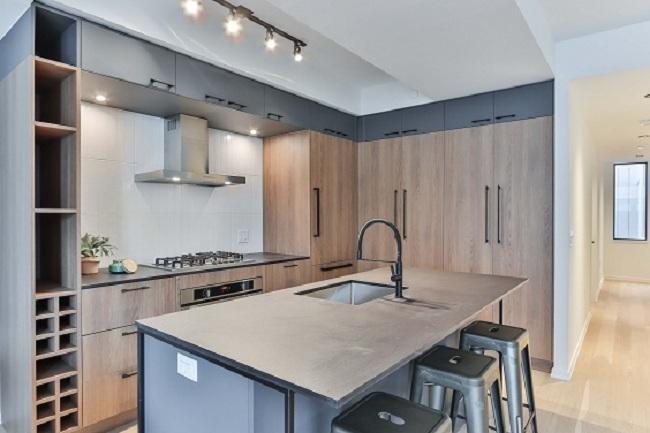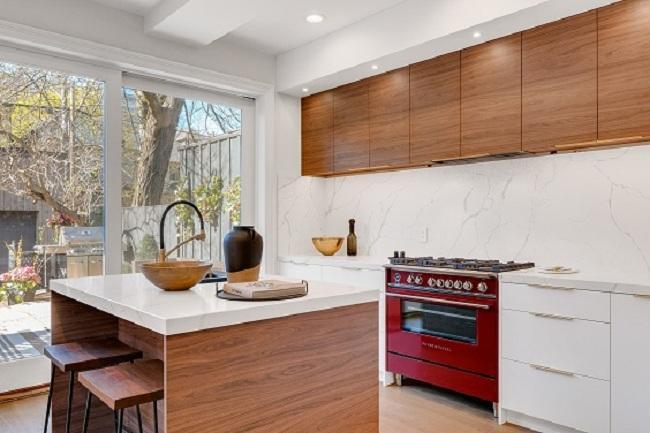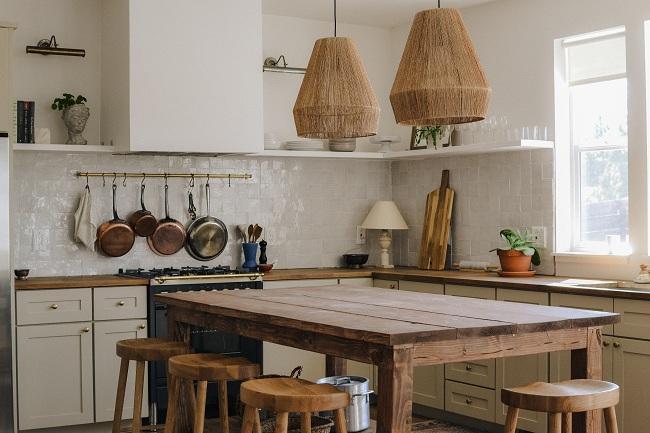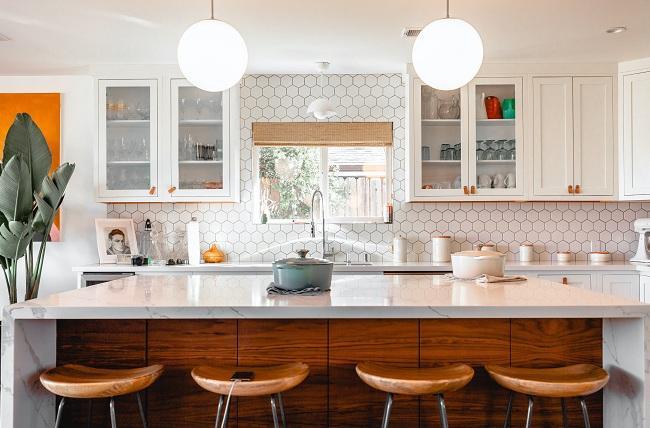A kitchen island is a freestanding countertop typically located in the center of a kitchen. It is a popular feature in modern kitchens, offering additional workspace and storage, as well as a focal point for socializing and entertaining.
Kitchen islands can come in a variety of sizes and styles, with some featuring built-in sinks, cooktops, or even seating for dining or casual conversation. They can be made from a range of materials, including wood, granite, marble, and stainless steel.
(You may also love: 10+ Inspiring Kitchen Remodel Ideas That’ll Make You Stunned)
How to Choose the Right Kitchen Island
We have prepared a few tips that you can use as a reference on how to choose the right kitchen island based on different aspects.
Based on Materials

When it comes to purchasing a kitchen island, the material it’s made of is an essential consideration. Here are some buying tips based on the different materials:
- Wood: Wooden kitchen islands are a popular choice for their warmth and natural beauty. When choosing a wooden kitchen island, look for high-quality, durable woods like oak, maple, or cherry. Ensure that the wood is sealed or treated to protect it from moisture and stains.
- Stainless steel: Stainless steel is a popular choice for modern and industrial-style kitchens. Look for high-quality stainless steel that is easy to clean and resists scratches and dents.
- Granite or Marble: These natural stone materials offer a sophisticated and luxurious look to a kitchen island. However, they are porous and need to be sealed to prevent staining. When choosing granite or marble, ensure that it’s a high-quality slab that doesn’t have cracks or fissures.
- Concrete: Concrete is a trendy and durable material for a kitchen island. Look for a high-quality mix that has been sealed to resist stains and scratches. Concrete kitchen islands can be customized with different textures and finishes to match your kitchen’s style.
- Butcher block: Butcher block is a popular choice for its natural look and durability. When selecting a butcher block kitchen island, look for high-quality hardwoods that are resistant to scratches and moisture damage. The surface of a butcher block should be regularly sealed and oiled to protect it from stains and water damage.
(You may also love: Stunning Minimalist Kitchen Ideas to Create a Stylish Hub)
Based on Purposes

When purchasing a kitchen island, it’s important to consider the purpose you want it to serve in your kitchen. Here are some buying tips based on different purposes:
- Additional workspace: If you need extra workspace, consider a kitchen island with a large countertop that provides ample room for food prep. Look for islands with a smooth, durable surface that can handle heavy use.
- Storage: If you need more storage space in your kitchen, look for an island with cabinets, drawers, or shelves. Think about what you want to store in the island and choose an island with storage options that meet your needs.
- Seating: If you want your kitchen island to serve as a dining area, consider an island with seating options. Look for islands with comfortable seating that fits the size of your family or the number of guests you plan to host.
- Cooking: If you plan to cook on your kitchen island, consider an island with a built-in cooktop or sink. Look for islands with durable surfaces and easy-to-clean materials that can handle spills and splatters.
- Focal point: If you want your kitchen island to serve as a focal point in your kitchen, look for an island with unique design elements or features. Consider islands with statement-making materials or eye-catching details that match your kitchen’s style.
(You may also love: Attractive Open Kitchen Ideas to Enhance Your Minimalist Home)
Based on Sizes

When purchasing a kitchen island, size is an essential consideration. Here are some buying tips based on the size of the island:
- Consider the available space: Before buying a kitchen island, measure the available space in your kitchen to ensure that the island will fit. Allow for at least 36 inches of clearance around the island to provide adequate space for movement.
- Think about the size of your family: When choosing the size of your kitchen island, consider the size of your family and how many people will be using it. If you plan to use the island as a dining area, ensure that it can comfortably seat everyone.
- Assess the functions you need: The size of your kitchen island should also be determined by the functions you need it to serve. If you plan to use it for food prep, cooking, and storage, choose an island with ample surface area and storage options.
- Determine your budget: Larger kitchen islands tend to be more expensive, so it’s essential to determine your budget before making a purchase. Consider the cost of the island itself, as well as any additional features or customization options.
- Choose a size that fits your kitchen’s style: When selecting the size of your kitchen island, consider how it will fit with the overall style of your kitchen. If you have a small kitchen, a large island may overpower the space. If you have a larger kitchen, a smaller island may look out of place.
(You may also love: Astonishing Kitchen Lighting Ideas to Brighten Up Your Hub)
Based on Price

Here are some buying tips based on the price:
- Determine your budget: Before you start shopping, determine your budget for a kitchen island. This will help you narrow down your choices and avoid overspending.
- Compare prices: Research different types of kitchen islands and compare prices from various retailers. Look for sales, discounts, and promotions that may help you save money.
- Consider materials: The materials used to make a kitchen island can greatly impact its price. For example, a marble countertop will be more expensive than a laminate one. Consider which materials are most important to you and which ones you can compromise on to stay within your budget.
- Choose a simple design: Complex or custom designs can greatly increase the cost of a kitchen island. Opt for a simpler design that still meets your needs and fits your style to save money.
- Look for pre-assembled or ready-to-assemble options: Pre-assembled kitchen islands tend to be more expensive than those that require assembly. Consider your level of experience with assembly and installation when making your decision.
(You may also love: Stunning Kitchen with Islands Ideas for More Optimize Space)
A kitchen island can be a valuable addition to any kitchen, offering additional counter space, storage, and functionality. When purchasing a kitchen island, it’s important to consider factors such as the purpose, function, size, material, and price. By taking these factors into account, you can choose a kitchen island that meets your needs and enhances the functionality and style of your kitchen.
